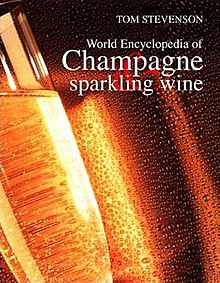
Champagne is a sparkling wine originated and produced in the Champagne wine region of France under the rules of the appellation, that demand specific vineyard practices, sourcing of grapes exclusively from designated places within it, specific grape-pressing methods and secondary fermentation of the wine in the bottle to cause carbonation.

The wine region within the historical province of Champagne in the northeast of France is best known for the production of champagne, the sparkling white wine that bears the region's name. EU law and the laws of most countries reserve the term "champagne" exclusively for wines that come from this region located about 160 kilometres (100 miles) east of Paris. The viticultural boundaries of Champagne are legally defined and split into five wine-producing districts within the historical province: Aube, Côte des Blancs, Côte de Sézanne, Montagne de Reims, and Vallée de la Marne. The city of Reims and the town of Épernay are the commercial centers of the area. Reims is famous for its cathedral, the venue of the coronation of the French kings and a UNESCO World Heritage Site.

Sparkling wine is a wine with significant levels of carbon dioxide in it, making it fizzy. While the phrase commonly refers to champagne, European Union countries legally reserve that term for products exclusively produced in the Champagne region of France. Sparkling wine is usually either white or rosé, but there are examples of red sparkling wines such as the Italian Brachetto, Bonarda and Lambrusco, and the Australian sparkling Shiraz. The sweetness of sparkling wine can range from very dry brut styles to sweeter doux varieties.

Dom Pierre Pérignon, O.S.B., was a French Benedictine monk who made important contributions to the production and quality of Champagne wine in an era when the region's wines were predominantly still red. Popular myths frequently, but erroneously, credit him with the invention of sparkling Champagne, which did not become the dominant style of Champagne until the mid-19th century.
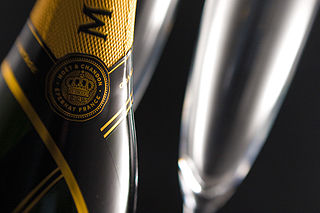
Moët & Chandon, also known simply as Moët, is a French fine winery and co-owner of the luxury goods company LVMH Moët Hennessy Louis Vuitton SE. Moët et Chandon is one of the world's largest champagne producers and a prominent champagne house. Moët et Chandon was established in 1743 by Claude Moët, and today owns 1,190 hectares of vineyards, and annually produces approximately 28,000,000 bottles of champagne.

White wine is a wine that is fermented without skin contact. The colour can be straw-yellow, yellow-green, or yellow-gold. It is produced by the alcoholic fermentation of the non-coloured pulp of grapes, which may have a skin of any colour. White wine has existed for at least 4,000 years.
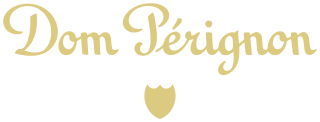
Dom Pérignon is a brand of vintage Champagne. It is named after Dom Pérignon, a Benedictine monk who was an important quality pioneer for Champagne wine but who, contrary to popular myths, did not discover the Champagne method for making sparkling wines.
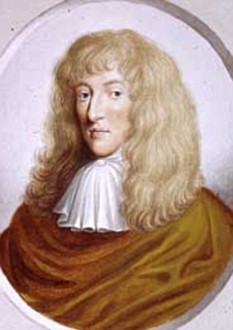
Christopher Merret FRS, FRCP, also spelt Merrett, was an English physician and scientist. He was the first to document the deliberate addition of sugar for the production of sparkling wine, and produced the first lists of British birds and butterflies.

Bollinger is a French Champagne house, a producer of sparkling wines from the Champagne region. They produce several labels of Champagne under the Bollinger name, including the vintage Vieilles Vignes Françaises, Grande Année and R.D. as well as the non-vintage Special Cuvée. Founded in 1829 in Aÿ by Hennequin de Villermont, Paul Renaudin and Jacques Bollinger, the house continues to be run by members of the Bollinger family. In Britain, Bollinger Champagnes are affectionately known as "Bolly".
The glossary of wine terms lists the definitions of many general terms used within the wine industry. For terms specific to viticulture, winemaking, grape varieties, and wine tasting, see the topic specific list in the "See also" section below.
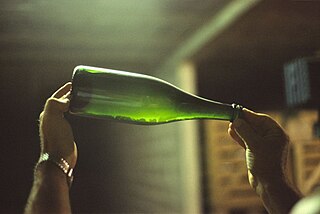
The traditional method is the process used in the Champagne region of France to produce Champagne. It is also the method used in various French regions to produce sparkling wines, in Spain to produce Cava, in Portugal to produce Espumante and in Italy to produce Franciacorta. The method is known as the méthode champenoise, but the Champagne producers have successfully lobbied the European Union to restrict the use of that term within the EU only to wines produced in Champagne. Thus, wines from elsewhere cannot use the term "méthode champenoise" on products sold in the EU, and instead the term "traditional method" or the local language equivalent. South African wines from the Western Cape are labelled with the term Methode Cap Classique. Some wine producers in countries outside the EU may disregard EU labeling laws and use méthode champenoise or even “Champagne” on labels for products not exported to the EU, but this usage is decreasing.

Sparkling wine production is the method of winemaking used to produce sparkling wine. The oldest known production of sparkling wine took place in 1531 with the ancestral method.
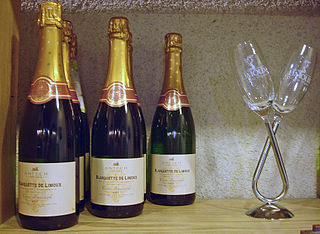
Limoux wine is produced around the city of Limoux in Languedoc in southwestern France. Limoux wine is produced under four Appellation d'origine contrôlée (AOC) designations: Blanquette de Limoux, Blanquette méthode ancestrale, Crémant de Limoux and Limoux, the first three of which are sparkling wines and dominate the production around Limoux. The main grape of the region is the Mauzac, locally known as Blanquette, followed by Chardonnay and Chenin blanc. In 2005, the Limoux AOC was created to include red wine production consisting of mostly Merlot. Wine historians believe that the world's first sparkling wine was produced in this region in 1531, by the monks at the abbey in Saint-Hilaire.

A champagne glass is stemware designed for champagne and other sparkling wines. The two most common forms are the flute and coupe, both stemmed; holding the glass by the stem prevents warming the drink. Champagne can also be drunk from a normal wine glass, which allows better appreciation of the flavor, at the expense of accentuating the bubbles less.
Oeil de Perdrix is a rosé wine produced in Switzerland. The history of the wine style dates back to the Middle Ages in the Champagne region of France and from there spread to the Canton of Neuchâtel in Switzerland where it would become a popular dry rosé made from pinot noir. The name œil de perdrix means "partridge's eye" in French, a reference to the pale pink colour of the eye of a partridge in death throes. Until about a century ago, it was common for vineyards to have the red and white grapes unseparated unlike today where each vineyard has a unique grape. This gave white wine, red wine, and what was called grey wine because the wine was neither white nor red. It is also an old name for very pale rosé wine made not by the saignée method, but by "pressurage direct", in which the juice of red grapes is drawn off and fermented with very little contact with the skins. With the modernization of viticulture and separation of grapes, the term Oeil de Perdrix disappeared in France, but remained in the Canton of Neuchâtel in Switzerland. The Canton of Neuchâtel would export Oeil de Perdrix primarily to the German-speaking cantons of Switzerland, but also to other cantons, namely to the cantons of Geneva, Vaud, and Valais. After the Second World War, the latter decided to start producing their own Oeil de Perdrix. When the policy for wine of controlled origin (AOC) in Switzerland began, the Canton of Neuchâtel claimed the sole Oeil de Perdrix AOC, but it was refused; the cantons of Geneva, Vaud, Valais, and Neuchâtel all have the Oeil de Perdrix AOC today. The early origins of the American wine White Zinfandel can be traced to a California winemaker's attempt at making an Oeil de Perdrix–style wine.

Tom Stevenson is a British wine writer and critic. Described by his colleagues as one of today's most prolific wine authors, Stevenson is regarded as the world's leading authority on Champagne. He has written 23 books, the most important of which have been published internationally by more than 50 publishers and translated into over 25 languages. In 1986, his book Champagne became the first wine book to win four literary awards, establishing Stevenson's reputation as a serious author, a fastidious researcher with a talent for divining future issues, and a critic bold enough to take on the establishment.
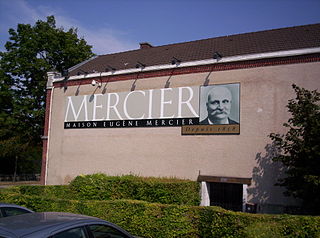
Mercier is a Champagne producer based in the Épernay region of Champagne. The house, founded in 1858 by Eugène Mercier, produces both vintage and non-vintage cuvée, which is stored in 18 km (11 mi) long cellar tunnels located 30 m (98 ft) underground. Parts of the cellar are open to the public, where visitors can use rail carts to navigate the tunnels. Today, the house owns 576 ha of vinyards. Mercier owned the original rights to the name Dom Pérignon but gave the brand to Moët et Chandon in 1927. Today the house is under the umbrella of the LVMH group and is the number one selling brand of Champagne in the domestic French market.

The history of Champagne began when the Romans planted vineyards in this region of northeast France in the 5th century, or possibly earlier. Over centuries, Champagne evolved from being a pale, pinkish still wine to a sparkling wine. When Hugh Capet was crowned King of France in 987 at the cathedral of Reims, he started a tradition that brought successive monarchs to the region—with the local wine being on prominent display at the coronation banquets. The early wine of the Champagne region was a pale, pinkish wine made from Pinot noir.
Schramsberg Vineyards is a winery located in Calistoga, California in the Napa Valley region. The vineyard, which was founded in 1862 by the German immigrant Jacob Schram, produces a series of sparkling wines using the same method as champagne. Schramsberg is considered one of the premium brands in the production of sparkling wine in California and the first U.S. wine to "match the style and quality of the best French Champagnes".

English sparkling wine is sparkling wine from England, typically produced to the traditional method and mostly using the same varieties of grapes as used in Champagne – Chardonnay, Pinot noir and Pinot Meunier. English sparkling wine producers often employ Champagne terminology to describe the styles of their wine, such as "Classic Cuvée", "Blanc de Blancs" or "Demi-Sec".
